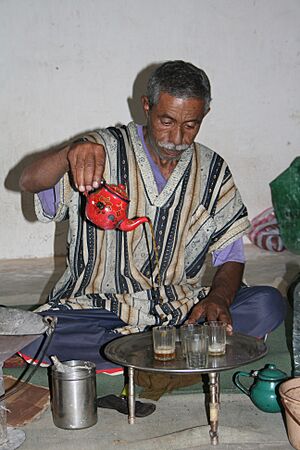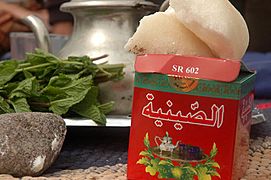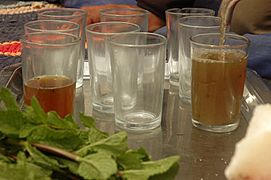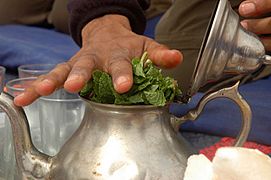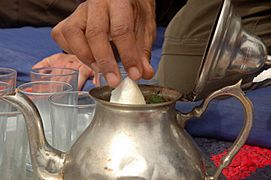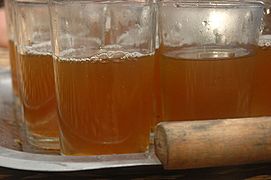Maghrebi mint tea facts for kids
| Alternative names | Atay, Atay b'naanaa, Shay-b'naanaa. |
|---|---|
| Region or state | North Africa |
| Associated national cuisine | |
| Serving temperature | Hot |
Mint tea from North Africa, also known as Moroccan mint tea, is a special green tea. It is made with fresh spearmint leaves and sugar. People in North Africa love this tea.
This tea is a big part of life in the Maghreb region. This area includes countries like Morocco, Algeria, Tunisia, Libya, and Mauritania. The tea is also popular in other parts of North Africa, the Sahel region, France, Spain, and the Arab world.
Mint tea is very important for social gatherings in the Maghreb. It is also popular with the Tuareg people in Algeria, Libya, Niger, and Mali. Serving the tea can be a special ceremony, especially for guests. The oldest male in the family often makes the tea. Offering tea shows how welcoming the family is. Usually, at least three glasses of tea are served. People drink this tea all day long when they are together.
The mint used is a special kind called naʿnāʿ (نعناع). It has a clear, strong, and mild smell. Sometimes, other types of spearmint are used if naʿnāʿ is not available. In Morocco, people sometimes add other herbs, flowers, or orange blossom water to the tea. In cold weather, they might add warming herbs like pennyroyal mint or wormwood. Mint has been used as a medicine for a long time in the Mediterranean. It was even used in Algeria to help with cholera between 1835 and 1865.
History of Mint Tea
Green tea, called Gunpowder tea, first came to North Africa in the 1700s and 1800s. It arrived through Morocco and Algeria from Britain.
A food historian named Helen Saberi says that drinking green tea with mint spread from Morocco. It then went to Algeria, Tunisia, Libya, Egypt, and to the nomadic Berber and Tuareg tribes in the Sahara desert.
Sugar and tea came from Europe to the port of Essaouira. Jewish merchants helped move these goods into Morocco. An explorer named James Richardson wrote about a Moroccan tea ceremony in the 1840s. He said that tea was drunk widely all day during his travels.
Drinking tea became a sign of importance in Morocco. A person named Ahmed Bin Mubarek became the first "master of tea" (mūl atay). Tea imports grew a lot after 1856. This happened partly because the East India Company sent tea meant for other countries to Morocco during the Crimean War.
At first, only people in cities drank tea. It showed their high social standing. But during tough times in the 1880s, more people started drinking tea. It became a way to get some calories and stop hunger. It also helped people from the countryside fit in when they moved to cities.
Another reason tea became popular in Morocco was that coffee was not as common. In Algerian cities, people drank coffee because of the Ottoman Empire. But coffee came to Moroccan cities later.
By the early 1900s, mint tea was very well-known in Morocco.
How to Make Mint Tea
The main things you need for mint tea are green tea, fresh mint leaves, sugar, and boiling water. The amount of each ingredient and how long you brew it can change. People in the Maghreb use very hot, boiling water. This is different from East Asia, where cooler water is used to avoid bitterness. The tea leaves stay in the pot while people drink the tea. This makes the flavor change a little with each glass.
The tea is poured into glasses from high up. This helps swirl the loose tea leaves to the bottom. It also adds air to the tea, which makes it taste better.
In winter, if fresh mint is hard to find, people sometimes use tree wormwood (called chiba or sheeba). This gives the tea a slightly bitter taste. Lemon verbena (called lwiza) is also used to add a lemon flavor. Other herbs like oregano, sage, and thyme can also be used. Sometimes, you can buy tea that is already mixed with dried mint. This is easier to store but has less flavor.
Here is a simple way to make mint tea:
- Put two teaspoons of tea leaves into a teapot.
- Add half a liter of boiling water. Let it sit for at least 15 minutes.
- Without stirring, pour the tea through a filter into a metal pot. This removes the leaves and powder.
- Add sugar. Use about one teaspoon of sugar for every 100 milliliters of tea.
- Heat the pot over medium heat until it boils. This helps the sugar dissolve.
- You can add fresh mint leaves to the teapot or directly to your cup.
Here is a more detailed way to make mint tea:
- First, put the tea in the teapot. Add a small amount of boiling water. Let it sit for about 20-30 seconds.
- Pour this first liquid out and save it. This is called the "spirit" of the tea. It adds a strong, deep flavor later.
- Next, "clean" the tea. Add a small amount of boiling water to the pot. Pour it out after one minute. This helps make the tea less bitter. You can repeat this step more than once.
- Now, add mint and sugar. The amount can vary, but about five teaspoons of sugar for one teaspoon of tea leaves is common.
- Pour boiling water into the pot.
- You can then put the pot on the stove and boil it more to make the flavor stronger.
- After three to five minutes, pour a glass of tea. Then pour it back into the pot two or three times. This mixes the tea well.
- Taste the tea. Add more sugar if you need to. Keep tasting until the flavor is just right.
Traditionally, the tea is served three times. Each glass tastes a little different because of how long it has been steeping. There is a famous saying about this:
The first glass is as gentle as life, the second is as strong as love, the third is as bitter as death.
In Popular Culture
In a famous song by Nass El Ghiwane called Es-Siniya (الصينية), the tea tray is used as a symbol. It talks about the difficulties of moving from the countryside to a big city like Casablanca.
See also
 In Spanish: Té con hierbabuena para niños
In Spanish: Té con hierbabuena para niños


